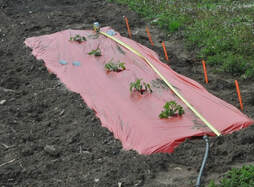 If you would like to have your tomato plants produce earlier in the year, there are certain things to keep in mind. Most people who try to get a jump on the season set their tomatoes out early and hope they do well. However, that is often not a good plan as tomatoes have to have certain requirements before they will grow well. Those requirements are an acceptable soil temperature for root growth and an acceptable air temperature for both plant growth and fruit set. Root Growth: Tomatoes need a soil temperature of at least 55 degrees to do well. Plastic mulch is most commonly used to warm the soil. Several days may be needed to raise the soil temperature. Check the soil temperature 2.5 inches deep in the soil at about 11:00 a.m. If that is not possible, check the temperature before leaving for work and again when you return and use the average of the two. It is best to lay a drip irrigation line before installing the plastic to make watering more convenient. See accompanying article on laying plastic mulch. Air Temperature: Plants must be protected from frost. Hot caps or water teepees are placed over the young plants to provide protection as well as provide a higher average temperature to encourage growth. Eventually the plants will outgrow the cover and start to develop flowers. But if the temperature goes below 55 degrees at night, tomato flowers may not set. The plant is not hurt, but the blossom will not set fruit, or, if it does set fruit, the fruit is often misshapen. How early can you transplant? Start with a date about 2 weeks earlier than normal. (Ward Upham) 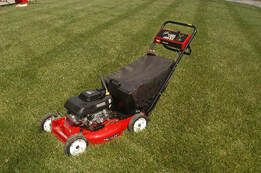 We often are asked whether it is good to mow lower in the spring. The answer is yes and no. It doesn’t hurt to mow lower than normal the first mowing or two. As a matter of fact, it can actually speed green-up by removing old, dead grass and allowing the soil to warm up more quickly. But the mowing height should be raised to normal after the first or second cutting to discourage crabgrass and encourage deep rooting. Crabgrass seed must have light to germinate, and a high mowing height will help shade the soil. Also, root depth and mowing height are related on upright growing grasses such as tall fescue and Kentucky bluegrass — the higher the height of cut, the deeper the root system. A deeper root system means a more drought-resistant turf. So, how low should you go on the first cutting? On tall fescue and Kentucky bluegrass, you can mow as low as 1 to 1½ inches. Be careful you don't go so low that you scalp the turf. After that, raise the mowing height for Kentucky bluegrass to 2 to 3 inches but 3 to 3½ inches for tall fescue. (Ward Upham) 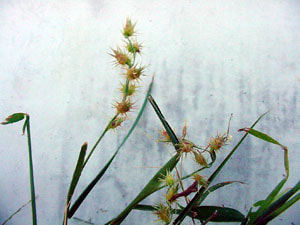 Grassy sandbur is the “sticker” plant that looks like a grass. It will often invade thin lawns, especially in dry years. Therefore, the best control for this weed is a thick, healthy lawn. However, if your lawn is thin this spring and grassy sandbur was a problem last year, use a preemergence herbicide before the sandbur comes up. However, not all preemergence herbicides are effective. The three products that can help minimize grassy sandbur are oryzalin, pendimethalin and prodiamine. Oryzalin is sold under the trade names of Surflan and Weed Impede. It can be used on all warm-season grasses as well as tall fescue. It should not be used on cool-season grasses other than tall fescue such as Kentucky bluegrass. Oryzalin is also sold as a combination product with benefin as Green Light Amaze. As with oryzalin alone, it can be used on all warm-season grasses as well as tall fescue. It should not be used on cool-season grasses other than tall fescue such as Kentucky bluegrass. Apply Amaze or an oryzalin product about April 15 when redbud trees approach full bloom. Pendimethalin is sold commercially as Pendulum as well as several other names. On the homeowner side, it is sold as Scotts Halts. Pendimethalin is best applied as a split application with the first half applied about April 15 and the second about June 1. Alternatively, make the first application when redbud trees approach full bloom and the second six weeks later. Prodiamine is sold under the commercial name of Barricade. It is also sold as a homeowner product Howard Johnson Crabgrass Control Plus with 0.37 Prodiamine 00-00-07. It can be used on all of our common lawn grasses. Apply as is done for oryzalin, about April 15 or when redbud trees approach full bloom. Only one application is needed per year. None of the “weed preventers” will give complete control but each should help. Quinclorac (Drive) can provide some postemergence control especially if the sandbur is in the seedling stage. Quinclorac is also found in a number of combination products that control both broadleaf weeds and crabgrass such as one of the following. Ortho Weed-B-Gon Max + Crabgrass Control BioAdvanced All-in-One Lawn Weed and Crabgrass Killer. Monterey Crab-E-Rad Plus Fertilome Weed Out with Crabgrass Killer Trimec Crabgrass Plus Lawn Weed Killer Bonide Weed Beater Plus Crabgrass & Broadleaf Weed Killer Spectracide Weed Stop for Lawns Plus Crabgrass Killer Again, the best control for grassy sandbur is a healthy, thick lawn. (Ward Upham) 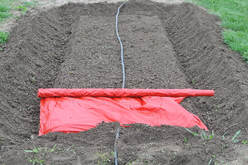 Plastic mulch is sometimes used to start vegetables such as tomatoes and melons earlier than normal. Commercial growers use a machine to lay the mulch, but home gardeners must do this by hand. Following are some tips on how this is done. 1. Fertilize according to soil test. You won't be able to add fertilizer after the plastic is down. 2. Work the soil so that the bed can be easily shaped. 3. Use a garden hoe to form a trench along all edges of the plastic. The soil should be pulled to the outside of the bed. The trench should be formed six inches in from the edge of the plastic and extend along both sides and both ends. The trench should be deep and wide enough to bury six inches of plastic. 4. Lay trickle irrigation tube down the center of the bed. This isn't absolutely necessary but it makes it much easier to water. Overhead watering will hit the plastic and roll off. 5. Lay the plastic down and cover the edges with soil. You need to slit the edge of the plastic where the trickle irrigation tube enters the end of the bed. 6. Plant when the soil temperature reaches the correct temperature for the crop (55 degrees for tomatoes and 60 degrees for melons) at a 2.5-inch depth. Check the temperature at about 11:00 a.m. to get a good average temperature. Check for several days in a row to ensure the temperature is stable. A hole can be made in the plastic by cutting and "X" in the plastic with a knife or by burning a hole with a hand-held propane torch. (Ward Upham) 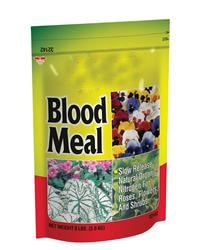
Most of the soil tests we receive for vegetable gardens are high in phosphorus and potassium leaving nitrogen as the nutrient needed most. However, many of our organic fertilizers contain similar amounts of all three nutrients.
So, what organic fertilizer can we use that provides more nitrogen then phosphorus and potassium? Following is a short list of such fertilizers.
​Feed stores will often sell these products. Colorado State University has an excellent publication on organic fertilizers. (Ward Upham)
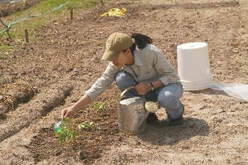 Transplant solutions are mild fertilizer solutions that are applied to newly transplanted vegetables and flowers. Transplant solutions are also called starter solutions or root stimulators. Early-season plants not given a transplant solution often develop a purplish tinge to the leaves caused by a phosphorus deficiency. Surprisingly, the soil may have plenty of phosphorus but plants often have difficulty taking up nutrients in cool soils. The starter solution places soluble nutrients near the roots so the plants get off to a good, strong start. Transplant solutions (root stimulators) are available for sale but it is also possible to make your own transplant solution from a fertilizer that contains more phosphorus than nitrogen or potassium such as a 5-10-5, 10-20-10 or 11-15-11. Mix 2 to 3 tablespoons of one of the above fertilizers in a gallon of water several hours before use. The fertilizer won't completely dissolve but enough will go into solution to get plants off to a good start. Use about 1 cup of transplant solution for each transplant. Sidedressing is a fertilization done after the plants are established. A fertilizer containing primarily nitrogen is used to keep plants growing and productive. Nitrate of soda (16-0-0) is often used at the rate of 2 pounds fertilizer per 100 feet of row. More commonly available lawn fertilizers such as a 30-3-3, 29-5-4 or something similar can also be used but cut the rate in half. Be sure any lawn fertilizer used does not contain weed preventers or weed killers. Note that most fertilizers weigh about 1 pound per pint of product. We have a sidedressing sheet available that lists crops, rate of fertilizer application and timing of application(s) for many common vegetables as well as annual flowers. The sheet can be viewed at https://tinyurl.com/j2ggaa6 (Ward Upham) 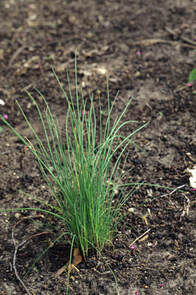 Wild garlic (Allium vineale) and wild onion (Allium canadense) are two closely related plants that can become weed problems in home lawns and landscapes. Though wild garlic and wild onion look much alike, each has an odor that is characterized by its name – wild garlic smells like garlic and wild onion smells like onion. These plants are perennials that can also reproduce by seeds and aerial bulbils. Bulbils form at the top of the stem and are oval and smooth. Wild garlic also reproduces by underground bulb offsets, but wild onion does not. Both species produce a clump of plants that is unsightly in a lawn. Control recommendations are the same though we now have a couple of new additions to our arsenal. Traditionally we have used 2,4-D or 2,4-D + MCPP + Dicamba (i.e., Trimec, Weed-Out, Weed-B-Gon). These products should be sprayed during March on a day that is at least 50 degrees. Newer products are Weed Free Zone and Speed Zone. Both are combination products that contain a formulation of Trimec plus carfentrazone. These will give a quicker response at cooler temperatures than 50 degrees. A spreader-sticker added to the spray should help any of these products be more effective. At times, the spreader-sticker is already mixed into the weed killer; no additional amount is needed. These herbicides are also effective on dandelions. Unfortunately, we have not had a good chemical control for Star-of-Bethlehem. The best products we had were Coolpower (31.3% control) and Turflon Ester (23.8% control). Coolpower is a commercial only product, but Turflon Ester is available to both commercial and homeowner users. But research out of Virginia Tech has improved our outlook. Scientists there did a study in which they gained 96% control of Star-of-Bethlehem one month after treatment by using Quicksilver, a formulation of carfentrazone at the rate of 4 fl. oz/A. Quicksilver is a commercial only product, and therefore is not readily available to homeowners. However, both Speed Zone and Weed Free Zone contain carfentrazone and would certainly be worth a try if you have this troublesome plant. (Ward Upham) 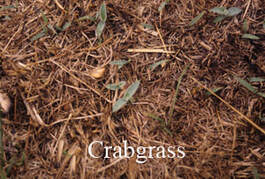 Crabgrass preventers are another name for preemergence herbicides that prevent crabgrass seeds from developing into mature plants. Many people have a somewhat foggy idea of how they work and assume they kill the weed seed. Such is not the case. They do not kill the seed or even keep the seed from germinating but rather kill the young plant after it germinates. Therefore, they do not prevent germination but prevent emergence. Crabgrass preventers are just that – preventers. With few exceptions they have no effect on existing crabgrass plants, so they must be applied before germination. Additionally, preventers do not last forever once applied to the soil. Microorganisms and natural processes begin to gradually break them down soon after they are applied. If some products are applied too early, they may have lost much of their strength by the time they are needed. Most crabgrass preventers are fairly ineffective after about 60 days, but there is considerable variation among products. (Dimension and Barricade last longer. See below.) For most of Kansas, crabgrass typically begins to germinate around May 1 or a little later. April 15 is normally a good target date for applying preventer because it gives active ingredients time to evenly disperse in the soil before crabgrass germination starts. Even better, base timing on the bloom of ornamental plants. The Eastern Redbud tree is a good choice for this purpose. When the trees in your area approach full bloom, apply crabgrass preventer. A follow-up application will be needed about 8 weeks later unless you are using Dimension or Barricade. Products that do require a follow-up application include pendimethalin (Scotts Halts) and Team (Hi-Yield Crabgrass Control). Dimension and Barricade are the only two products that give season-long control of crabgrass from a single application. In fact, they can be applied much earlier than April 15 and still have sufficient residual strength to last the season. Barricade can even be applied in the fall for crabgrass control the next season. Dimension can be applied as early as March 1. Because of the added flexibility in timing, these products are favorites of lawn care companies who have many customers to service in the spring. Though Dimension is usually not applied as early as Barricade, it is the herbicide of choice if it must be applied later than recommended. It is the exception to the rule that preemergence herbicides do not kill existing weeds. Dimension can kill crabgrass as long as it is young (two- to three-leaf stage). Dimension is also the best choice if treating a lawn that was planted late last fall. Normally a preemergence herbicide is not recommended unless the lawn has been mowed two to four times. But Dimension is kind to young tall fescue, perennial ryegrass, and Kentucky bluegrass seedlings and some formulations can be applied as early as two weeks after the first sign of germination. However, read the label of the specific product you wish to use to ensure that this use is allowed. Lawns established in the fall can be safely treated with Dimension the following spring even if they have not been mowed. Note that products containing Dimension and Barricade may use the common name rather than the trade name. The common chemical name for Dimension is dithiopyr and for Barricade is prodiamine. Remember, when using any pesticide, read the label and follow instructions carefully. We recommend crabgrass preventers be applied before fertilizer so that the grass isn’t encouraged to put on too much growth too early. However, it may be difficult to find products that contain preemergents without fertilizer. Those that don’t contain fertilizer are listed below. I didn’t find any products containing Barricade that did not also have a fertilizer. If anyone knows of other products that should be listed, let us know and we will publish them in a later newsletter. Pendimethalin - Scotts Halts Team (Benefin + Trifluralin) - Hi-Yield Crabgrass Control Dimension - Hi-Yield Turf & Ornamental Weed and Grass Stopper - Bonide Crabgrass & Weed Preventer - Green Light Crabgrass Preventer (Ward Upham) |
AuthorsCynthia Domenghini runs the Horticulture Response Center in the Department of Horticulture and Natural Resources at Kansas State University. Other contributors include K-State Extension Specialists. Archives
March 2024
Categories
All
|
| K-State Research and Extension Horticulture Newsletter |
|
 RSS Feed
RSS Feed
